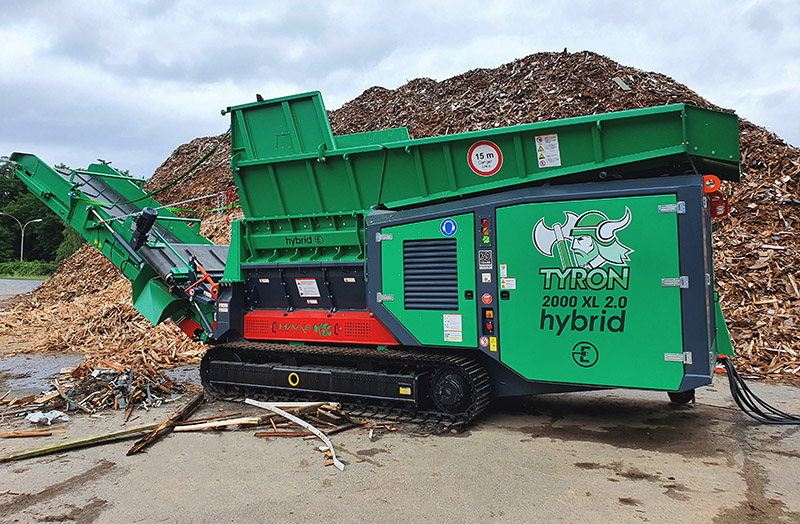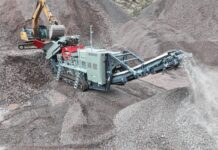Rob Symons, operations director of recycling/waste management machinery company CRJ Services, discusses the crucial role of the hybrid shredder in the future of the plant and construction sector
Do you ever wonder where your waste goes? Each year, more than 45 million tonnes of waste are sent to one of the 500 landfill sites across the UK. The world continues to struggle with a solution for waste, and whilst recycling where possible is the priority, many materials cannot be reprocessed, and therefore must be disposed of.
As a result, landfills and machines like industrial waste shredders continue to play an essential role. So what are hybrid shredders, what are the benefits of using one, and how do they compare to the traditional shredder?
What are hybrid shredders and why are they important?
Industrial waste shredders are machines that play a key role in the UK’s waste management, recycling, and disposal industries. Shredding waste is highly efficient in minimising the need for landfills: by shredding waste to separate various materials, sorting plants are able to receive more uniform materials, resulting in enhanced sorting efficiency, improved equipment functionality, and a greater proportion of recycled materials.
Traditional shredders are able to shred through commercial and industrial waste, from organic waste and plastic through to tyres and wood. These machines are able to chew through up to 40 tonnes of waste per hour, and provide the user with an accurate and consistent shred depending on how big or small they want the outcome.
While traditional shredders run on diesel alone, hybrid shredders utilise a dual-power system: a small diesel engine to drive the machine’s tracks and a larger electric motor to deal with the shredding itself.
With an increasingly environmentally conscious plant and construction industry, hybrid shredders represent a real opportunity for more sustainable business practices. They may not be as well-known as traditional shredders but we are slowly seeing more use as the industry recognises the range of advantages that make them an attractive, sustainable alternative.
The benefits of hybrid shredders
There are many benefits to hybrid shredders – not only are they more sustainable, but they also save businesses money at the same time. Whilst traditional shredders are able to tackle 40 tonnes of waste per hour, their hybrid counterparts can tackle an additional 10 tonnes in the same time frame. This greater throughput of waste means a reduction in carbon emissions, as the shredder doesn’t need to run as long in order to get the job done. Not only that, the machines require less maintenance as a result of not using an engine to power the shredding of materials. As a result, any organisation that does choose to adopt a hybrid shredder will get the best of both worlds: cost savings, and reducing the need for diesel considerably.
Furthermore, the resulting reduction of carbon emissions helps to bring businesses closer to their sustainability targets. This achieves two things: firstly, it is a major step towards helping the nation to achieve its national net zero 2050 target, by reducing up to 105 tonnes of co2 emissions per machine. Secondly, it will bolster an organisation’s sustainability credentials, which can lead to all kinds of benefits, including winning new business from climate-conscious customers.
Hybrid shredders also offer greater operational efficiency. Businesses can make use of real-time data collection and analysis to optimise shredding, achieve greater productivity and keep downtime to a minimum.
The problem/barriers to adoption
While the benefits of hybrid shredders are clear to see, there are certainly some challenges to wider adoption. Wide-scale adoption requires a shift in mindset. The industry is used to using red diesel-powered traditional shredders, and hybrid shedders are still viewed as something ‘on the horizon’. But businesses must realise that the transition is closer than they think.
In April 2022, the government abolished the use of red diesel to power off-road vehicles and equipment, meaning businesses had to make the switch to white diesel in accordance with new regulations. Unfortunately, white diesel has considerably increased the cost of operations when using a diesel engine. As a result, moving away from diesel where possible is not just going to be more cost effective, but will also future-proof your business from further regulation.
Just like electric cars, there is a sense of inevitability with hybrid shredders. But businesses can be put off by the up-front investment being 5% to 10% higher than that of traditional shredders.
However, there are solutions to this problem: prospective buyers could rent a machine on a ‘try-before-you-buy’ basis. Not only would this enable them to get to know the machine, but also understand how it would fit into their operations and what changes need to be made to accommodate a hybrid shredder.
A new era
Though still regarded as rare, hybrid shredders’ popularity is growing within the plant and construction industry. At CRJ Services, we have seen a significant increase in those enquiring about hybrid shredders, and have had a long history with their traditional counterparts.
We are seeing that the biggest adoption issues – such as infrastructure and mindset – are steadily being resolved as more businesses focus on increased throughputs, lower maintenance costs, and a reduced carbon footprint.
With this in mind, hybrid shedders could usher in a new, more sustainable era of shredding.









